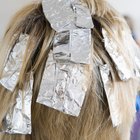Dying over highlights is a very challenging task with many things to consider. Often, several different colored dyes are used to achieve a look of an entire head of hair appearing one solid color. When dying over highlights, the highlights absorb color much easier than the rest of your hair, which makes it difficult to rid your hair of multiple color tones.
Consider making an appointment with a professional colorist. Dying over highlights to achieve hair with one even tone is a very difficult task. Professional results will be hard to achieve on your own unless you’ve had previous experience with color matching. Most likely, you will leave the salon the same day with perfect color over your highlights. Going to a colorist will be much more convenient and less time consuming.
Establish the overall color you are trying to achieve. If you decide to attempt this task on your own, you first need to decide what color you’d like your hair to turn out. Keep in mind that it is much easier to dye over highlights using darker-colored dyes. Lighter colors have a very broad color range possibility. This makes color matching much harder when dealing with multiple shades of hair. Darker colors have a much smaller range of color results.
Match dye colors accordingly. You will need to attain two different-colored dyes. First, you need your primary color. Your primary color is the dye that will be covering the majority of your hair, with the exception of your highlighted areas. This color will resemble the final desired hair tone. Second, you need a secondary color to reverse your highlights and make them appear the same color as the rest of your hair. This means choosing a color with the capability of the same tone as your primary color when applied over highlights.
Refer to your primary color in order to properly establish a secondary color. The primary color you have chosen is the basis of your decision because you want to choose a secondary tone that has the capability of matching your primary tone perfectly when applied over highlights. Make sure your secondary color is the same color tone as your primary color. For instance, if your primary color is an auburn brown you want to stick to different shades of brown with a red tint as well. In most cases, your secondary color should be two to three shades darker than your primary color.
Separate your hair. It is important that you dye your highlighted hair separately from the rest of your hair. Section off the highlighted areas of your hair using hair clips. To ensure that you don’t accidentally apply primary color to your highlights, it is recommended that you wrap your highlighted hair in tin foil.
Apply the primary hair color. Dye all of the hair present outside of the sectioned highlights. Apply even amounts of your primary hair color choice throughout your hair and let it sit for approximately 20 to 25 minutes. Once you have let the primary color sit, remove all hair clips and tin foil so that you can thoroughly rinse your hair. Towel dry your hair and brush out any knots or tangles.
Apply the secondary hair color to your highlights. To do this, you will need to use tinfoil once again in order to contain the highlighted hair within the tinfoil, as to not disrupt the rest of your hair with secondary color. Place a piece of tinfoil under a strip of highlighted hair and apply secondary color along the entire strands of the highlighted section. Gather the section of highlighted hair within the tinfoil and carefully fold the foil in half to ensure the dye stays in place. Once you have applied secondary color to all of your highlighted areas, check on the color every five minutes. Dye processes very quickly on light hair. It is important that you check back often to see when the color has reached its appropriate potential. You may need to leave the secondary dye to sit anywhere from 10 to 30 minutes. Once your highlights have processed to the appropriate color, rinse your hair thoroughly once again.
Related Articles

How to Highlight the Crown of Your Hair

How to Color Over Highlights

How to Turn Orange Highlights to Dark ...

How to Bleach Dyed Brown Hair

How to Color Block Hair With Foiling

How to Put Red Highlights Into Dark Hair

How to Use a 40% Developer With Toner

Hair Color Guide for Women Over 50

How to Cover Small Amounts of Gray Hair

Can You Use Regular Hair Dye to Make ...

How to Blend Hair Extensions With Two ...

How to Remove Henna From Hair

How to Dye Your Hair Pink From Dyed Red

How Long Should a Hair Toner Be Left on ...

How to Darken Permanently Lightened Hair

How to Get Rid of Highlights in Your ...

Difference Between Permanent Hair Color ...

How Long Should I Wait to Dye My Hair ...

How Can I Turn My Gray Hair Into ...

Can I Dye My Hair After Bleaching It?
Writer Bio
H.C. Hisel has worked for the past nine years as a professional writer, dancer, musician, painter and photographer. Hisel had her own weekly newspaper column in the Banana 411, a newspaper for kids. Her articles have been published in various print markets and online, including Trails.com and Golflink.com.